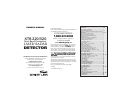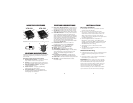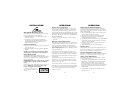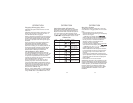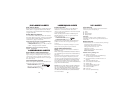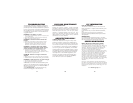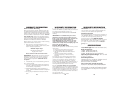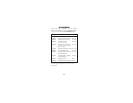
SPEED MONITORING
20
NOTE: It is the responsibility of the individual
radar detector owner to know and understand the
laws in your area regarding the legality of the use of
radar detectors.
Radar Facts
A radar gun operates by transmitting radio
waves at certain frequencies which reflect off
objects and are then picked up by the radar
gun’s receiving section. When a radar beam
reflects off a moving target, a measurable fre-
quency shift occurs. The radar unit converts this shift
into miles per hour to determine your vehicle’s
speed. Currently, the FCC (Federal
Communications Commission) permits opera-
tion of traffic radar guns at X Band (10.500 -
10.550 GHz), K Band (24.050 - 24.250 GHz), and
Ka Band (33.400 - 36.000 GHz).
Note: A radar detector will not alarm if an offi-
cer is not transmitting on any one of the above
radar bands.
POP
™
Mode
POP
™
Mode is a feature on some newer radar
guns operating on K and Ka bands. When the
gun is in POP
™
Mode and activated, a brief burst
of energy, less that 1/15 of a second, is transmit-
ted and the vehicle’s speed is quickly acquired. A
detector without POP
™
Mode detection capabili-
ty cannot respond to this brief transmission. This
detector has the power to report this new gun
where other detectors cannot!
Total Band Protection
™
Complete Band Coverage that detects laser,
radar, VG-2 and safety radar bands.
SPEED MONITORING SPEED MONITORING
21 22
Laser Facts
It’s well documented that many radar guns can-
not reliably provide the speed of a targeted
vehicle that is traveling in a group of vehicles. In
contrast, a laser gun can target a specific vehicle
out of a line of traffic and determine its speed.
The advantage of laser over radar in terms of tar-
get identification is the result of the laser gun’s
narrow beam. A radar transmission can cover
more than a four-lane highway at a distance of
1,000 feet, compared with a laser transmission
which covers about 3 feet at the same distance.
For best protection, keep these points in mind:
•
Because your vehicle’s license plate or
headlights ar
e the laser gun’s primary targets,
mounting your Whistler detector on the
dashboard can improve laser detection at
shor
t range.
• Do not follow closely behind any vehicle you
cannot see through. If you can’t see past a
vehicle ahead of you, chances are your
detector won’t either.
• The receiving range of your laser detector will
not be the same as a radar detector. Laser
guns are most often used at short range.
Whistler Laser-Radar detectors receive all cur-
rent laser guns which operate at a laser wave-
length of 905 +/- 10mm.
•Pro Laser
™
I II III •LT1 20-20 •Ultra Lyte
Laser Tips
If you are the targeted vehicle, a laser gun can
often determine your speed within a few sec-
onds after you receive an alert. In this situation
there is generally no time to safely adjust your
speed. However, if you are traveling near or
behind the targeted vehicle and receive an alert,
response time should be sufficient. Any laser
alert, regardless of duration, requires
immediate action!
Other Speed Detection Systems
Several techniques other than radar or laser are
used to measure vehicle speeds. When these
methods are being used, no detector can pro-
vide a warning. These techniques include:
• Pacing - A patrol car drives behind you and
matches your driving speed.
• Vascar/Aircraft - The time it takes a vehicle to
travel a known distance is measured.
WARRANTY INFORMATION
Consumer Warranty
This Whistler Laser-Radar detector is warranted
to the original purchaser for a period of one year
from the date of original purchase against all
defects in materials and workmanship. This limit-
ed warranty is void if the unit is abused, modified,
installed improperly, if the housing has been
removed, or if the serial number is missing. There are
no express warrantiescovering this product other
than those set forth in this warranty. All expressor
implied warranties for this product are limited to the
above time. Whistler is not liable for damages
arising from the use, misuse, or operation of this
product.
NOTE: Any damage to the remote battery or
batter
y leakage, water damage or any physical
damage is not covered under the warranty.
Check with the battery manufacturer about this
warranty.



